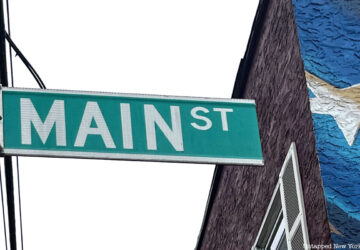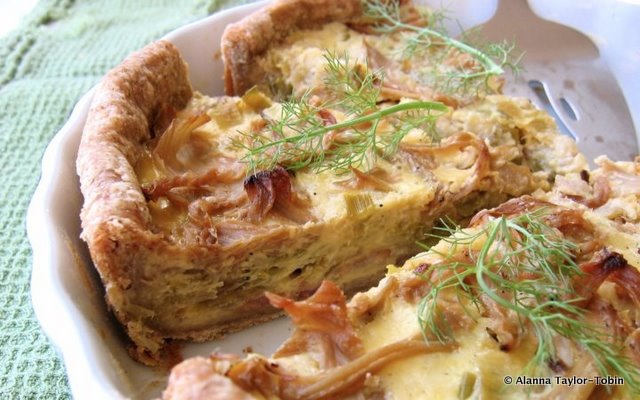Fennel grows like a weed all over coastal California. I used to love grazing on the herbaceous fronds while walking through Topanga Canyon wilderness during my childhood. (But then, I would eat pretty much anything.)
During my Potrero Hill ‘commute’ (a ten-minute walk) to Farley’s many years later, I would feel a nostalgic kinship with the forest of fennel that grows on a grassy hillside on 18th Street. Every month or so, some determined gardener would attempt to eradicate the fennel by mowing down the four-foot-high stalks. They would lay like fallen soldiers, their licorice scent wafting through the air. But to my delight, the fennel always won: the forest would re-grow to its previous majesty not a month later.
Since fennel grows so easily, I could never understand why the bulbs in the market were so darned expensive. Apparently, bulbed fennel is a different variety than the wild stuff, which doesn’t form those pretty, smooth-textured bulbs, and, presumably, it is harder to grow.
Luckily for me, Eatwell Farms has recently been gifting us large, pale green, frond-tufted orbs in our weekly boxes that brim with beautiful winter produce and eggs, and we’ve been in fennel heaven (which is not exactly the place where good fennel soldiers go, but it does smell the same). I paired one monster bulb with caramelized leeks and bacon for this savory tart.
I cooked up some lardons of super smoky, thick-cut bacon from the Corralitos Market, an old-school general store outside of Santa Cruz that specializes in smoked sausages and other meats. I cooked sliced leeks and fennel in the rendered fat until meltingly tender and caramelized, and deglazed the pan with a few splashes of white wine. At the bottom of a par-baked, whole-grain pate brisée, I put down a sprinkling of parmesan, which creates a barrier between custard and crust, then layered the bacon and veggies on top, and poured over a custard of eggs and cream, seasoned with a few generous grinds of black pepper.
It didn’t seem like very much bacon at first, but the finished tart is undeniably bacon-tastic. The lardons, which lose a lot of volume when first sauteed, seem to soak up liquid as the tart bakes, like those magically expansive sponges shaped like dinosaurs and such. I was surprised how much bacon meat and flavor ended up in the finished quiche. Isn’t there some cliché about quiche being un-manly? A “quiché”? Well this tart would be the answer to that.
Despite the abundant baconage, the fennel can be tasted, its clean anise flavor layering the sweet leeks and smoky meat. The bright-yolked eggs from Eatwell turned the custard a rich yellow. The crust flakes tenderly against the creamy custard, and all that vegetable matter makes this substantial enough for brunch, lunch or supper, accompanied by a crisp salad (preferably made with chicories and arugula to counteract the sweet richness of the quiche).
If you’re stuck with an over-abundance of fennel, try using it anywhere you would celery: in egg, tuna or potato salad, in a mirepoix, in a soup (such as Lentil Soup with Chestnuts and Fennel), or on a platter of crudites.
Or give me a call, and I’ll take it off your hands.
Bacon, Leek and Fennel Quiche
Makes one 9 or 10″ quiche, about 8 servings
If you’re not of the mind that everything tastes better with bacon (and even more better with more bacon), use the lesser amount listed here; or, for a vegetarian version, omit it entirely and cook the leeks and fennel in equal parts butter and olive oil.
Serve wedges of this tart with a crisp salad, preferably made with pungent greens such as arugula and/or chicories.
All-butter crust:
3/4 cup all-purpose flour
1/2 cup whole spelt (or whole wheat pastry) flour
1 teaspoon sugar
1/2 teaspoon salt
4 ounces (8 tablespoons/1 stick) cold, unsalted butter, in 1/2″ dice
about 4 tablespoons ice water
Meat and veggies:
4-8 ounces bacon (preferably thick-cut, smoky; see headnote)
1 tablespoon olive oil
3 medium-large leeks
about 1/3 cup dry white wine (such as sauvignon blanc)
sea salt
1 large fennel bulb, a few feathery fronds reserved for garnish
Cheese and custard:
2 ounces grated parmesan (about 3/4 cup)
3 large eggs
3/4 cup half and half
1/2 cup heavy cream
1/2 teaspoon salt
a few turns of freshly ground black pepper (about 1/4 teaspoon)
Make the crust:
In a large bowl, stir together the flours, sugar and salt. Scatter the butter pieces over the flour, and rub in with your fingertips until the mixture resembles sand with lots of pea-sized butter chunks. Drizzle the ice water over, 1 tablespoon at a time, tossing with a rubber spatula, until the dough will hold together when you give it a squeeze. Dump the dough out onto a counter, divide it roughly into 6 portions, and fraisage by dragging a portion of dough across the counter using the heel of your hand. Scrape up the dough, gently press it into a ball and flatten into a disc. Slip it into a plastic bag, and chill for at least an hour or up to 2 days.
Remove the dough from the fridge, unwrap, and place on a lightly floured surface. Roll out the dough into a 12″ circle, dusting the dough lightly with flour as needed, rotating and flipping it to prevent it from sticking. Ease the dough into a 10″ quiche pan (or a 9″ pie pan or 9″ deep tart pan), fit it into the corners, and trim it to a 1″ overhang. Fold the overhang inside to create double-thick walls, and press firmly into the sides of the pan. (Hint #1: if you make the crust 1/4″ higher than the sides of the pan, you will allow for a bit of shrinkage. Hint #2: Save any dough scraps in case the crust bakes up with a tiny hole or tear; you can patch up the hole and avoid a leaky [read: not “leeky”] tart)
Chill the crust for 20 minutes, then freeze it for 20 minutes.
Position a rack in the lower third of the oven and preheat to 400 º. Remove all other racks from the oven.
Place the frozen crust on a rimmed baking sheet. Line it with a piece of parchment paper, and top with pie weights, dry beans, or clean pennies, pushed into the corners of the crust to hold it up.
Bake the crust for 20 minutes, then remove the weights and parchment and bake until the bottom is lightly golden, 5-10 minutes longer.
Reduce the oven to 350 º.
While the tart dough is chilling and baking, make the filling:
Warm the oil in a large skillet over medium-high heat. Add the bacon pieces and cook, stirring frequently, until browned and crispy, about 5 minutes. Remove the bacon to a bowl, leaving behind the fat. Pour off all but 1-2 tablespoons of bacon fat and reserve.
Slice the leeks in half lengthwise, then slice the white and light green parts crosswise 1/4″ thick. Place the leeks in a large bowl and fill with cool water. Let the leeks sit for a few minutes, swishing them around occasionally to dislodge any dirt or sand.
Heat the skillet with the fat in it over medium-high. Gently lift the leeks out of the water, shaking off excess moisture, and add them to the pan. Cook the leeks, stirring and scraping the pan frequently with a metal spatula until they reduce in volume and begin to caramelize, about 10 minutes. Turn the flame down to medium low and continue cooking the leeks until meltingly tender, splashing in wine as needed when the pan looks dry, about 10 more minutes. Season with 1/4 teaspoon salt. Scrape the leeks out of the pan and into a small bowl to set aside.
Cut the fennel bulb in half lengthwise, place the cut sides down, then slice the bulb thinly lengthwise. If you see any dirt or sand inside the layers of fennel, place the pieces in a bowl of water as you did with the leeks to remove any gritty bits. Add another tablespoon of bacon fat to the now-empty skillet and warm over medium heat. Add the fennel and cook, stirring occasionally, until the fennel is golden, adding wine the pan as needed, about 5 minutes. Turn the heat down to low, cover the pan, and cook the fennel until it is very tender, stirring occasionally, 5-10 more minutes. Season with a pinch of salt.
Assemble and bake the tart:
Spread the parmesan over the bottom of the crust. Scatter the bacon pieces over the cheese. Spread the leeks over the bacon, and finally arrange the fennel over the leeks.
In a large measuring cup, whisk the eggs to combine thoroughly. Whisk in the half and half, cream, salt and pepper. Pour the custard mixture over the tart.
Bake the tart in a 350 º oven until set-the edges are slightly puffed, and there’s no wet liquid if you peek under a piece of fennel in the center-50-60 minutes.
Let the tart cool to warm, 30 minutes or so. Cut into wedges and serve warm. The tart is best the day it is baked, but will keep, refrigerated, for up to 3 days. Re-warm before enjoying.







